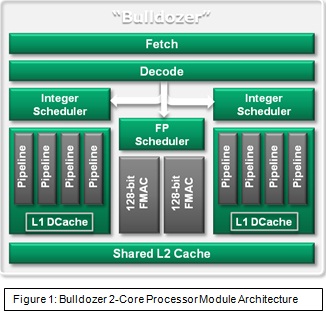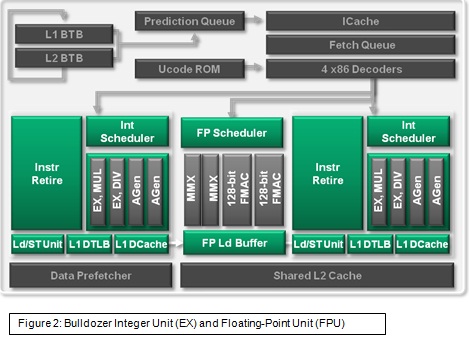AMD will launch the all new Bulldozer microarchitecture in Q2. This will be the company’s first new architecture in many years and it carries great expectations. AMD has released some additional details on the design of the architecture and not the least the 2-core CPU module, the heart of Bulldozer.
AMD has built a CPU module that the company calls dual-core. The truth is that the CPU module doesn’t have two copies of everything, but the integer cluster are two and according to AMD 80% of all instructions handled by a CPU core is done on integers. Even if floating point calculations is handling by a single execution unit AMD expects to reach 80% of the performance of a genuine dual-core CPU in multi-threaded applications. In single-threaded or integer-intense loads performance should be even closer.
Bulldozer’s CPU modules requires 213 million transistors each and is made with 32 nanometers higk-k metal gate SOI CMOS technology. Each module is designed to operate at voltages between 0.8V and 1.3V. The major advantage, says AMD, is that it uses the transistors of the architecture more efficiently and thus increase performance at high clock frequencies (3.5GHz+), power consumption and size of the circuit.
AMD points out that the processor still consumes 50% of the power in a regular desktop PC, which is why an efficient microarchitecture is extremely important, hence Bulldozer. This not only spawns from the facts that the CPU module shares resources like L2 cache, floating point unit and such, but AMD has taken this one step further.
The company has revised more or less every power consuming component of the architecture and optimized them. Bulldozer can turn off different parts of the architecture to save power at low loads, while a new generation Turbo CORE technology will result in maximal performance at high loads.
AMD revealed no benchmark numbers for the new Bulldozer architecture, but processors based on the new technology is expected to find its way into servers and desktop over the coming months.
More information on AMD’s Bulldozer architecture can be found at blogs.amd.com.

















